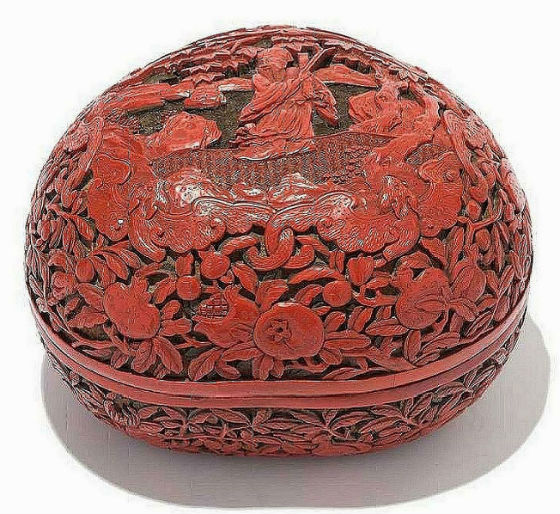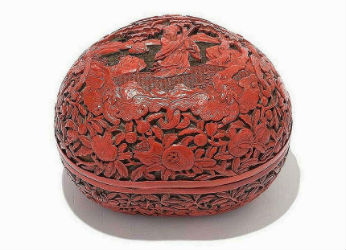
NEW YORK – Asians have long used lacquer, a sap derived from a family of native trees, as incense, in medicine and as painted ornamentation. Yet carving lacquer is exclusively a Chinese art.
Many carved lacquered pieces, infused with powdered cinnabar, are red, an auspicious shade symbolizing joy, luck, life and eternity. Others are polychrome, integrating green, yellow or purple-tinted lacquer layers.
Luxurious carved lacquer decorations have adorned Chinese Imperial temples and palaces for thousands of years. Craftsmen began carving lacquer “pictorial” pieces depicting birds, flowers or floral arrangements, however, under the Song Dynasty (960–1279). As designs became increasingly complex, wealthy patrons stored personal items, like sealing paste, scrolls and cosmetics, in small, lavishly carved boxes, while members of the imperial court presented large ones, brimming with coral, pearls, gems or gold coins, or other riches to mark special occasions. The imperial court also commissioned red and black carved lacquer trays, platters, tea caddies, incense boxes and tiered food boxes. Most, considering their fragility and laborious production, were likely reserved for ceremonial purposes.

Creating a carved lacquer box, depending on its size and design, might take years. Initially, a single, sticky, paper-thin, glossy lacquer layer was meticulously applied to a base of bamboo, cloth or local wood. As it slowly air-dried in the warm, humid environment, the lacquer hardened into a highly durable, natural plastic, impervious to water and heat. A second layer was then applied in the same manner, followed by another, another and another. With the addition of each, the surface of the box thickened. When it reached a depth of one-eighth to one-quarter inch, carving could begin.

Yet pieces featuring deeper lacquer surfaces, perhaps over 200 layers, enabled creating far more detailed, three-dimensional carved designs. Moreover, those composed of tinted, shale-like under-layers may also reveal intriguing interplays of color. A red lacquer layer, for example, may be carved down to a yellow layer worked as a lattice. This, in turn, may be carved down to a green layer worked as a leafy diaper pattern. A single slip of the knife, however, might require starting again, from the beginning.
In addition to deep, crisp, colorful carving, the finest Chinese lacquerwares feature delicate, harmonious designs. Most available today date from the Ming (1368-1644), and Qing (1636–1912) dynasties.

Ming carved lacquer trays, tables, tiered boxes and cricket cages, for example, often depict naturalistic, densely carved landscapes against decorative trelliswork or fine, geometric diaper grounds. Most are embellished with lush floral or foliate scrolled borders. Scores, depicting scholars playing chess or studying scrolls, elders holding staffs, women strolling beside pavilions or farmers plowing their fields, celebrate everyday Chinese life. Others depict Foo lions, the Eight Buddhist Treasures (among them eternal knots, jeweled parasols and lotus flowers), or beloved narratives like Luohan Taming the Tiger.
Many Ming carved lacquer designs feature auspicious motifs, like the phoenix, symbolizing balance and harmony, and benevolent, scaly dragons, symbolizing imperial power. Others include lucky images of bats, bamboo, butterflies, plum blossoms, pine trees or peonies.

Yet plump, rosy-skinned peaches, which traditionally granted immortality to all who ate them, may be the most fortuitous carved lacquer motifs of all. These appear not only in carved pictorials but also as peach-shaped, carved lacquer boxes. Some are simply designed. Others, in addition to central and auspicious “Chun”|characters celebrating youth and joy, may contain sets of nine smaller boxes. These embody the popular nine-peach motif, which in addition to immortal life, is associated with the heavens. No wonder the Imperial Court bestowed them on especially significant birthdays.
During the reign of Qianlong, emperor of the Qing Dynasty and devotee of carved lacquerware, production of traditional, intricate designs not only continued but thrived. Many adorn simple wall vases, tea caddies, offering boxes, urns and snuff bottles. Scores ornament majestic lacquerware tables, screens, cabinets and throne chairs. Others embellish superb lacquered “treasure boxes.”

These rare, meticulously carved Imperial works of art, whether square, lobed, rectangular or round, whether open-tiered or closed, typically abound in polychrome naturalistic, auspicious and geometric motifs set against rich diaper grounds. Many are held in museums or bound for palatial surroundings.
Yet an appealing, well-carved 19th century trinket box or brush pot will also bring this glorious Chinese art form home.



